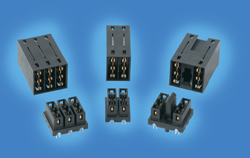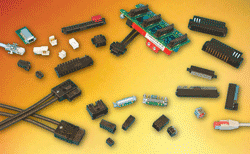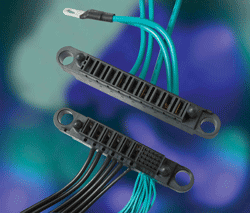Connector performance is only one measure of a successful product
BY JOHN DODDS
FCI, Etters, PA
http://www.fci.com/hcihighpower
System designers are being asked to increase overall power efficiency while maintaining or even increasing system functionality, while increased rack density and higher wattage power supplies are requiring more effective thermal management. At the connector level, this translates into power products that can handle higher power requirements, offer reduced losses due to resistance, and facilitate additional airflow.
These increased performance demands apply across various market segments – data, telecom and datcom/networking to name a few – and are driving component manufacturers toward significant advances in product technology while equipment form factors are becoming more compact. As an example, the denser blade form-factor is replacing rack-mount servers in data centers. Consequently, greater power (and signal) density is needed to accommodate these more compact systems (see Fig. 1 ).

Fig. 1. Compact two- and three-position power modules enable increased linear power density along the daughter card edge. The backplane and midplane connectors are intended for host-to-card applications such as the blade, controller card or line card interfaces in servers, storage enclosures, networking or communications equipment.
Connector trends
Power connector technology is evolving to meet these trends as connector manufacturers provide products that maximize linear current density in more compact, lower-profile packages. For example, linear current density, product profile heights, and airflow above, below and through the power connector are key design criteria. In addition to compactness, power connectors must also offer better milli-volt drop performance to help system designers achieve better power efficiency (see Fig. 2 ).

Fig. 2. Today’s system designs increase overall power efficiency while increasing functionality. At the connector level, this requires meeting higher power requirements, offering reduced losses due to resistance, and facilitating additional airflow.
To satisfy these system power requirements, connector manufacturers have responded with next-generation power products that benchmark standard stamped-and-formed power contact technology. This technology combines high power density with cost effectiveness versus expensive screw-machine contacts for high-current applications. In addition, high-conductivity copper alloy materials, optimized power contact designs and housing ventilation in strategic areas help next-generation products meet and exceed the demands of higher power applications. For example, one recently introduced power connector system includes features of an existing SSI-compliant connector that is standard for ac/dc power supply interfaces and power distribution. However, it uses a new and enhanced power contact design. The various design enhancements enable a single power contact to achieve 82 amps per contact based on a 30°C temperature-rise and zero airflow. This high-power density connector solution is ideal for high-wattage power supply applications in servers, storage enclosures, communications equipment and hot-swap redundant n+1 power distribution systems. This product houses power and signal contacts for power distribution and control in a single integrated connector thus providing incredible flexibility to system designers. Its modular tooling approach facilitates highly customizable configurations to meet a variety of power application needs (See Fig. 3).

Fig. 3. This power distribution connector system includes power and signal contacts to provide power distribution and power control in a single connector. The connectors are ideal for robust power connections to embedded ac/dc power supplies or for board-to-board connections in servers, storage enclosures and communications equipment.
For midplane/backplane-to-daughter card applications, the benefits of combining signal and power delivery into a single connector are particularly apparent in high-speed applications. One available product with shieldless technology allows signal and power Insert Molded Leadframe Assemblies (IMLAs) to be mixed within a single connector facilitating very flexible pin configurations. This connector is available in versions for backplane and orthogonal applications and offers the greatest signal and power density in all three dimensions. It also provides a combined signal/power connector option that meets thermal, mechanical and high-speed requirements without requiring new tooling.
In some midplane/backplane-to-daughter card applications, however, power needs are significant enough to require separate, stand-alone power connectors. For applications where high-speed signal connectors do not offer sufficient power density via signal contacts to handle these elevated power requirements, connector manufacturers have developed stackable power modules that can easily be placed adjacent to other host-to-card components. These products have the flexibility to stack high-speed and power modules adjacent to one another along the card edge providing for end-to-end stackable solutions.
Flexible solutions
As design cycles continue to decrease, connector manufacturers who offer flexible product solutions are preferred. System designers need highly configurable products that meet a wide range of application requirements including board-to-board, cable-to-board and cable-to-cable solutions. This is evident in the power connector market where preferred suppliers offer one-stop shopping using a wide breadth of product including power supply and host-to-card solutions as well as cable assemblies for power distribution. A flexible product portfolio targeted at key system design applications demonstrates the connector manufacturer’s commitment to the power market as well as an understanding of evolving power connector needs.
In today’s market, a given connector’s performance is one measure of a successful product. In an industry where “standard” products are sometimes commonplace, it might be tempting to simply judge a connector by its price. However, system designers should also consider the manufacturer behind the product including the value of the company’s technology, design capabilities, quality and service. Also, the appropriate agency approvals (such as UL, CSA, TUV, etc) are needed to demonstrate a commitment to safety as well as to obtain system safety compliance.
In addition, customers are best-served when power connector solutions are available from multiple sources. Multiple sources ensure continuity of supply, shorter lead times, competitive pricing and superior customer support.
As cycle times decrease and available system design resources continue to shrink, connector suppliers can better serve customers by offering more accessible, hands-on assistance in the evaluation and specification of product. Ensuring customer satisfaction also requires assistance with specifying existing (or designing new) products, quoting, sampling and procurement activities thus further enhancing the customer’s overall experience. In addition to on-site support, the selection process can be streamlined with a Web-based guide to finding products that best fit a specific application. Online information can address a wide variety of commonly asked questions regarding product features and capabilities in addition to providing easy access to 3D models, performance parameters, data sheets and application notes. This helps system designers to streamline the design-in process and speed time to market.
System designers have many choices when specifying power products so connector suppliers with innovative designs, highly configurable products and easy-to-use support functions will help their customers achieve satisfaction and success. ■
Advertisement
Learn more about FCI Electronics





